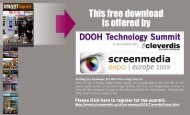Out-of-Home Digital Media are - Cleverdis
Out-of-Home Digital Media are - Cleverdis
Out-of-Home Digital Media are - Cleverdis
Create successful ePaper yourself
Turn your PDF publications into a flip-book with our unique Google optimized e-Paper software.
an ad is currently having upon consumers in<br />
the store, and by predicting what messages<br />
and promotions will be most relevant to<br />
these consumers, combined with the ability<br />
to dynamically alter messages based upon<br />
such relevant information, a DCN can build<br />
retail brand equity. The collection <strong>of</strong><br />
customer demographic and behavioral<br />
data makes precision in-store messaging<br />
possible. The output is strategies and<br />
processes for creating and distributing<br />
targeted messages.<br />
So messages should be readily tailored to<br />
respond to and/or stimulate a consumer<br />
need?<br />
Yes… by knowing which and when specific<br />
consumers <strong>are</strong> in a store, as well as<br />
incorporating other relevant market factors,<br />
advertisers can direct their spending to the<br />
most likely time and place that a consumer<br />
is ready to buy. A simple example… if it is<br />
raining outside, umbrella sales can be<br />
advertised; if the local soccer team is<br />
winning, video segments and related<br />
merchandise can be promoted.<br />
What about leveraging cross-product and<br />
up-product relationships?<br />
By understanding product relationships<br />
relative to consumers in the store, BEM data<br />
analysis will illustrate and adapt to obvious<br />
and not-so-obvious customer/product<br />
relationships, and deliver relevant<br />
advertising real-time to stimulate purchase<br />
behavior.<br />
Tell us about other direct advantages in<br />
retail…<br />
The introduction <strong>of</strong> new products or services<br />
or their uses is a major one. Consumer<br />
targeted in-store messages in a similar<br />
manner to current in-store marketing, such<br />
as POP and graphics, but in a consumer<br />
directed, dynamically enhanced manner. In<br />
terms <strong>of</strong> dynamic pricing, BEM enhances<br />
the ability to quickly alter product pricing<br />
relative to changing environmental factors.<br />
This can range from increasing the price <strong>of</strong><br />
umbrellas on rainy days to targeted price<br />
reductions based upon inventory levels.<br />
These price adjustments may be facilitated<br />
www.cleverdis.com<br />
by the retailer, the CPG, or both. Then there<br />
<strong>are</strong> targeted promotions. Here, data<br />
analysis and predictive modeling powered<br />
by BEM enables advertisers to optimize<br />
promotions. BEM collection <strong>of</strong> customer<br />
demographic and behavioral data makes<br />
precision targeting <strong>of</strong> promotional ads via<br />
RDS possible. Further, predictive<br />
promotional modeling can isolate<br />
promotional attributes with the highest<br />
customer impact, with the benefit that ad<br />
promotional effectiveness can rapidly be<br />
tested and refined prior to rolling out a<br />
national campaign. As a result <strong>of</strong> increased<br />
message relevancy, brand recall and<br />
persuasion will be positively impacted. A<br />
DCN can impact brand equity, which<br />
results in increased loyalty, by building<br />
brand aw<strong>are</strong>ness, brand associations, and<br />
brand reinforcement.<br />
How does “predictive promotional<br />
modeling” work?<br />
The goal <strong>of</strong> predictive promotional<br />
modeling is to isolate and emphasize those<br />
aspects <strong>of</strong> a specific promotional campaign<br />
that will achieve the maximum impact upon<br />
customers at the store level. This modeling<br />
may include the use <strong>of</strong> experimental design<br />
and other statistical prediction rules to<br />
project the impact upon consumer purchase<br />
behavior relative to individual promotional<br />
PART 1• <strong>Out</strong> <strong>of</strong> <strong>Home</strong> <strong>Digital</strong> <strong>Media</strong> Applications<br />
stimuli to determine which promotional<br />
attribute would likely result in the strongest<br />
consumer response.<br />
Then comes campaign management. What<br />
<strong>are</strong> your thoughts on this?<br />
Based upon analytics and modeling,<br />
content and play lists <strong>are</strong> developed. This<br />
information is feed to content management<br />
s<strong>of</strong>tw<strong>are</strong> for store level programming.<br />
Integration into other promotional activities<br />
being undertaken by the retailer and CPG<br />
should also be considered.<br />
How can one measure the effectiveness <strong>of</strong><br />
the campaign?<br />
The intersection <strong>of</strong> POS data and content<br />
play lists reveals whether the message is<br />
achieving the intended result. This<br />
information will aid in comprehending the<br />
following: the messages sales impact;<br />
advertising and promotional effectiveness,<br />
organizing future campaigns and cross<br />
sell/up-sell accuracy. The BEM system is<br />
updated with new information to become<br />
more intelligent to further enhance<br />
customization and ad effectiveness. This<br />
envisions a reincorporation <strong>of</strong> learning’s into<br />
new campaigns to fully leverage RDS’s<br />
potential through BEM.<br />
<strong>Out</strong> <strong>of</strong> <strong>Home</strong> <strong>Digital</strong> <strong>Media</strong> SMARTreport January-July 2008 / 11<br />
© Photo: ScreenRed













